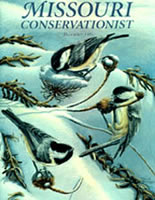When winter gray has settled across the southern Ozarks, you can still find a bit of green in the landscape, if you know where to look.
Mistletoe grows naturally in southern Missouri. Look for it in river valleys, growing on sycamore, elm, river birch and other trees.
Mistletoe is semi-parasitic. Its host provides water and some nutrients, but mistletoe leaves contain chlorophyll and manufacture a share of its own food.
Mistletoe's white berries are poisonous to humans and many animals, but like poison ivy, birds spread the seeds. When the berries are ripe, birds eat them, then wipe the sticky pulp from their beaks on branches. Often the seed is left with the pulp. Droppings are another way the seeds are spread.
Mistletoe is a slow grower; it may take several years before it can be seen from the ground. And mistletoe is not as common as it once was.
In late December, though, during the holidays, mistletoe is found decorating homes throughout Missouri
And More...
This Issue's Staff
Assistant Editor - Tom Cwynar
Managing Editor - Jim Auckley
Art Director - Dickson Stauffer
Artist - Dave Besenger
Artist - Mark Raithel
Composition - Kevin Binkley
Photographer - Jim Rathert
Photographer - Paul Childress
Staff Writer - Joan McKee
Staff Writer - Charlotte Overby
Composition - Libby Bode Block
Circulation - Bertha Bainer






















